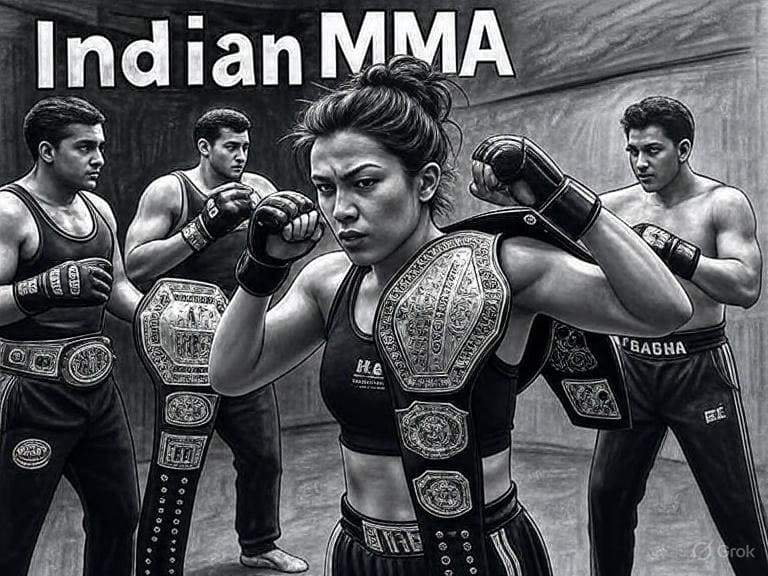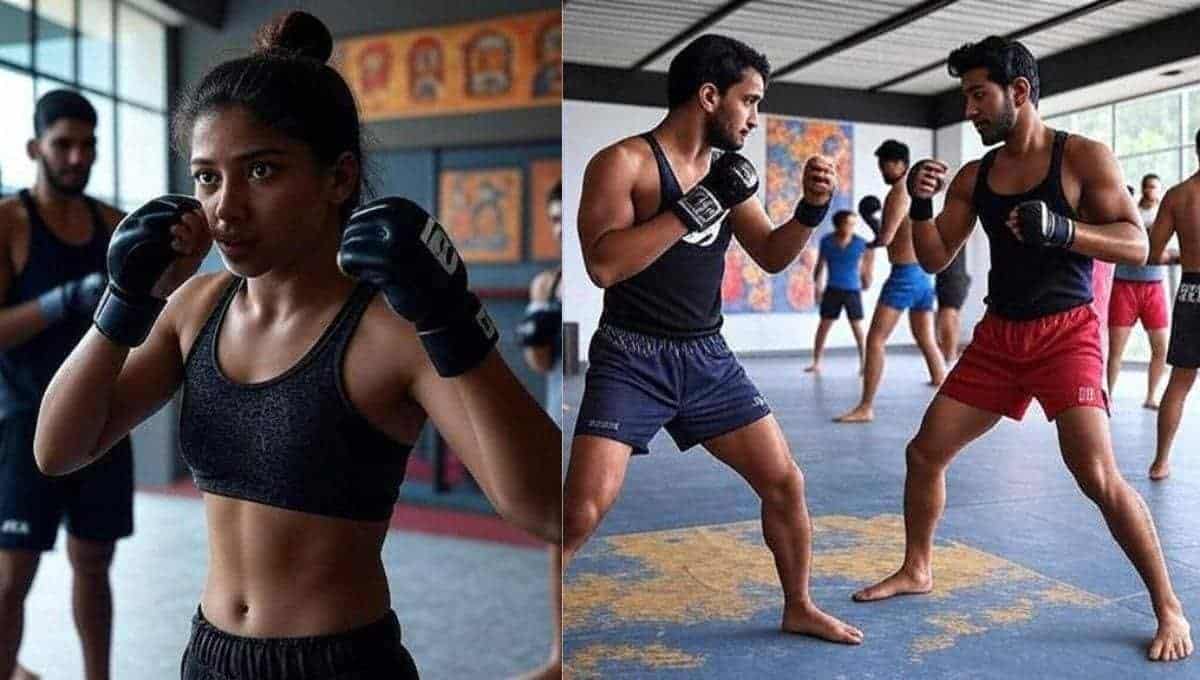Mixed Martial Arts (MMA) has taken the world by storm, and India is no exception. Over the past decade, Indian MMA has emerged as a vibrant and rapidly growing scene, with grassroots gyms and training camps playing a pivotal role in this exciting evolution. From small-town dojos to urban training hubs, these facilities are nurturing talent, fostering discipline, and creating a pathway for Indian fighters to compete on global stages like the UFC. In this blog post, we will explore why Indian MMA is booming, the critical role of grassroots gyms, and how training camps are shaping the future of combat sports in India.
The Rise of Indian MMA: A New Era for Combat Sports
The popularity of Indian MMA is soaring, driven by a combination of cultural shifts, increased access to training, and the global influence of promotions like the UFC. Unlike traditional sports like cricket or field hockey, MMA offers a unique blend of athleticism, strategy, and raw excitement that resonates with India’s youth. The rise of Indian fighters like Puja Tomar and Anshul Jubli, who have competed in the UFC, has inspired a new generation to take up combat sports. But what’s fueling this growth at the grassroots level?
Grassroots gyms and training camps across India are providing aspiring fighters with the tools, training, and opportunities to succeed. These facilities are not just gyms-they are communities where passion for MMA thrives. From Delhi to Guwahati, these hubs are transforming the Indian MMA landscape by offering structured training, access to experienced coaches, and a platform for fighters to hone their skills.
The Role of Grassroots Gyms in Indian MMA
Grassroots gyms are the backbone of the Indian MMA movement. These local training centers are often run by passionate coaches who are dedicated to building a strong foundation for the sport. Unlike large commercial gyms, grassroots facilities focus on accessibility, affordability, and fostering a sense of community. Here’s how they are driving the Indian MMA boom:
- Affordable Training for All: Many grassroots gyms offer low-cost or subsidized training programs, making MMA accessible to people from diverse economic backgrounds. This inclusivity is critical in a country like India, where financial barriers can limit participation in sports.
- Community-Driven Approach: These gyms create a sense of camaraderie and support, encouraging fighters to push their limits. For example, gyms like Dojang MMA Studio in Guwahati and Warriors Cove in Delhi have become hubs for local talent, fostering a tight-knit community of fighters and coaches.
- Focus on Skill Development: Grassroots gyms emphasize fundamental skills like striking, grappling, and Brazilian Jiu-Jitsu (BJJ). They provide a safe space for beginners to learn and advanced fighters to refine their techniques.
- Nurturing Local Talent: Many Indian MMA fighters, such as Mridul Saikia, who trains at Dojang MMA Studio, have risen through the ranks thanks to grassroots gyms. These facilities identify and nurture talent early, helping fighters transition from amateurs to professionals.
The impact of grassroots gyms is evident in the growing number of Indian fighters competing in domestic promotions like Matrix Fight Night and international tournaments like Road to UFC. These gyms are not just training grounds—they are incubators for the next generation of Indian MMA stars.
The Emergence of MMA Training Camps in India
While grassroots gyms provide the foundation, specialized MMA training camps are taking Indian MMA to the next level. These camps offer intensive, structured programs designed to prepare fighters for professional competitions. Unlike regular gym sessions, training camps focus on holistic development, combining physical conditioning, technical training, and mental preparation. Here’s why training camps are a game-changer for Indian MMA:
- World-Class Coaching: Many training camps in India collaborate with international coaches or send fighters to train abroad. For instance, Puja Tomar and Anshul Jubli train at Soma Fight Club in Bali under striking coach Mike Ikelei, gaining exposure to global training standards.
- Comprehensive Training Programs: Training camps offer a mix of disciplines, including Muay Thai, BJJ, wrestling, and strength conditioning. This multidisciplinary approach ensures fighters are well-rounded and prepared for the demands of MMA.
- Access to Competitions: Many camps are connected to domestic and international promotions, providing fighters with opportunities to compete. Events like Bidang Fighting Championship and Sangai MMA offer platforms for fighters to showcase their skills and gain recognition.
- Mental and Physical Resilience: Training camps emphasize mental toughness, discipline, and recovery, which are essential for success in combat sports. Fighters learn to handle pressure, recover from injuries, and stay focused during high-stakes bouts.

Training camps are bridging the gap between grassroots gyms and professional MMA, helping Indian fighters compete on global stages. As more camps emerge, they are creating a pipeline for talent to flow from local gyms to international arenas.
The Influence of UFC GYM and Global Standards
The arrival of UFC GYM in India has added a new dimension to the Indian MMA scene. As a global brand, UFC GYM brings world-class facilities, standardized training protocols, and a professional environment to the country. While grassroots gyms focus on accessibility, UFC GYM caters to those seeking a premium training experience. Here’s how UFC GYM is contributing to the Indian MMA boom:
- Professional Facilities: UFC GYM offers state-of-the-art equipment, dedicated MMA training areas, and access to certified coaches. This elevates the training experience for both amateurs and professionals.
- Global Brand Recognition: The UFC name carries significant weight, attracting aspiring fighters who want to align themselves with the world’s leading MMA promotion. This brand appeal is inspiring more people to take up MMA training.
- Technology Integration: UFC GYM’s partnership with MMA.INC, which uses BJJLink.com as its gym management software, streamlines operations and enhances the training experience. This technological edge helps gyms scale and support more fighters.
- Inspiration for Aspiring Fighters: The presence of UFC GYM in India motivates fighters to aim for the UFC, the pinnacle of MMA competition. It serves as a reminder that Indian fighters can compete at the highest level.
While UFC GYM may not be as accessible as grassroots gyms, its presence is raising the bar for MMA training in India. It complements the efforts of local gyms by providing a professional pathway for fighters who have honed their skills at the grassroots level.
Challenges and Opportunities for Indian MMA
Despite its rapid growth, Indian MMA faces several challenges. Limited access to elite training facilities, lack of government support, and cultural perceptions about combat sports as a career choice are significant hurdles. However, these challenges also present opportunities for growth:
- Expanding Infrastructure: As MMA grows, there is a need for more high-quality gyms and training camps across India. Investments in infrastructure can make training more accessible in rural and semi-urban areas.
- Government Support: Initiatives like those advocated by Sangram Singh, who won his debut MMA fight in 2024, could encourage the Indian government to fund MMA programs and support young athletes.
- Cultural Acceptance: As Indian fighters achieve success on global stages, MMA is gaining acceptance as a legitimate career path. Grassroots gyms and training camps are playing a key role in changing perceptions by showcasing the discipline and dedication required in the sport.
By addressing these challenges, India can solidify its position as a global MMA powerhouse. The groundwork laid by grassroots gyms and training camps is already showing results, with fighters like Raiwat Sagdeo and Siddharth Singh making waves in the amateur and professional scenes.
Recent Developments in Indian MMA
The Indian MMA scene is buzzing with recent developments that highlight its growth. Here are some notable updates:
- Puja Tomar’s UFC Journey: Puja Tomar, India’s first female UFC fighter, is set to compete in UFC London, aiming to boost India’s presence in global MMA. Her success is inspiring countless young fighters.
- Mridul Saikia’s Road to UFC: Assam’s Mridul Saikia is competing in the Road to UFC tournament in Shanghai, with a chance to earn a UFC contract. His journey reflects the growing talent pool in India.
- Siddharth Singh’s Vision: BJJ athlete Siddharth Singh, who organizes the Abu Dhabi Jiu Jitsu Pro (AJP) Tour in India, aims to see an Indian win a UFC title belt and a BJJ black-belt world championship. His efforts are elevating the sport’s profile in India.
These milestones underscore the impact of grassroots gyms and training camps in nurturing talent and creating opportunities for Indian fighters.
Conclusion: The Future of Indian MMA
Indian MMA is on an upward trajectory, fueled by the passion and dedication of grassroots gyms and training camps. These facilities are not just training grounds—they are the heart of a movement that is transforming combat sports in India. From providing affordable training to fostering world-class talent, they are laying the foundation for a new era of Indian MMA. As more fighters like Puja Tomar, Anshul Jubli, and Mridul Saikia emerge, the dream of seeing an Indian UFC champion is closer than ever.
If you’re inspired to join the Indian MMA revolution, now is the time to act. Find a local gym, sign up for a training camp, or explore UFC GYM’s offerings to start your journey in combat sports. Share your thoughts in the comments below, and let us know how you’re contributing to the growth of Indian MMA. Together, we can make India a global powerhouse in mixed martial arts!

